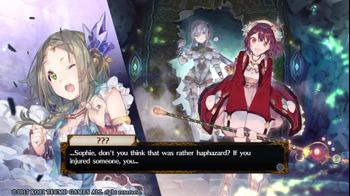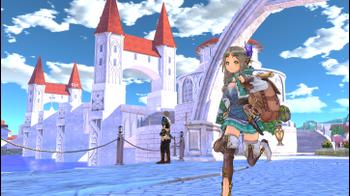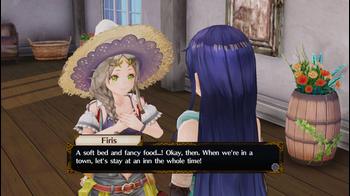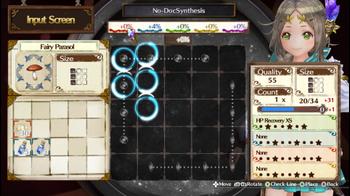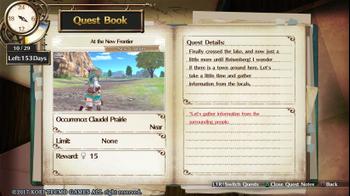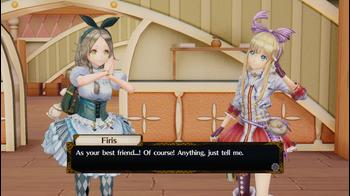
Atelier Firis: The Alchemist and the Mysterious Journey Review
To me, the Atelier series has been great in turning on the charm and putting me into a much better mood as I play it. It’s almost therapeutic in how it pulls me in close and wraps around me like a warm blanket. The fact the stories never get too serious makes a lot of my cares and stresses melt away the more I play.
Atelier Firis: The Alchemist and the Mysterious Journey does a brilliant job at this thanks in large part to its very likeable cast. Although each character has their own backstory and motivation, they all play off each other so well. Gust has continously managed to do this despite having to introduce a largely new cast of characters, though it's not always seamless. This is easily the biggest game Gust has ever made, both in sheer size and the amount of content to indulge in, but does it stick the landing?
Set shortly after the events of Atelier Sophie, Firis and her sister Liane live in a small, underground mining town located on the outskirts of society. Firis spends most of her time helping the workers mine for ore with her gift of locating the best spots to dig, while Liane head out into the wilderness to hunt for food.
This causes Firis to yearn for her own opportunity to explore outside - so much so she visits the large door barricading the town from the outside world multiple times a day. Her eagerness is highly evident as she welcomes her sister Liane home, begging to hear stories about her adventures. It’s gotten to the point where she reads books about the world every night before she falls asleep. This is clearly painful for Liane to witness.
After a certain alchemist makes an appearance, Firis is finally able to achieve her dreams of standing beneath the blue sky rather than the rocky caves she spent most of her life under. But to maintain her newfound freedom, she must pass an official exam to become a licensed alchemist and earn permanent independence from her home.
While I ended up enjoying the overall plot, the pacing can be all over the pace, especially with how it drags down to a standstill halfway through the game. However, once I cleared the hump, I was able to have a lot of fun with what was unfolding and really looked forward to what was going to happen next. The sense of wonder the story creates and the way Firis engages with everything around her as she explores the world makes for a fantastic experience.
The environments in Atelier Firis look and feel a whole lot larger in terms of scale than its predecessors. While most of the maps in other games tend to bottleneck or loop around narrow walkways, this time the paths are nice and open wherever you go. And to avoid being lost, the game allows you to set multiple markers for quests and the like.
The world map can be accessed at any time through various signposts, letting you access anywhere you’ve visited to previously. There are also traveling merchants walking along the roads, ready to buy and sell items.
The towns are practically gigantic in comparison to what us fans are used to. Instead of a single hub city, there are multiple towns and villages to visit that are scattered around the world. It really adds a grand scope that was missing from the series. The only downside here is the small number of people roaming about, making many places feel almost deserted.
Even the ateliers are now made up of multiple rooms. Sure, they may not always serve a purpose other than having party members standing around, but it’s appreciated.
The game doesn’t quite go far enough to warrant it being called an open world game - it lacks the breadth of side content, sprawling design, and spontaneity warranting the description - but it’s not hard to envision a scenario where that type of genre is now possible for Gust if they decide to go down that route.
Thanks to the generous draw distance, you can spot different gathering points and enemies down each path to warrant investigation. With new sub quests to discover, I enjoyed exploring every corner of the world.
Unlike the more recent entries in the Atelier series, the time management feature makes its return - sort of. You are basically given a year to venture around the world perform various activities before an important event is to occur. Still, you’re given an awful lot of time so it still shouldn’t be an issue, and once you complete the main story, the time limit goes away.
There is also a new stat called LP. This is consumed by taking actions while out on the field, from fighting enemies to gathering materials.. The lower the LP, the fewer the amount of materials you will gather at each point. You can recover this by either synthesizing new items or resting at a bed in the atelier.
The first time your LP hits 0, you’ll rest and regain some LP. After that, Firis faints and you’re sent back to camp. Not a big loss, but it will interrupt players if they’re in the middle of exploring which is a bummer. Your battle items also won’t replenish inside the atelier - you’ll have to keep making new ones, though I always had a wealth of duplicate items at my disposal.
The day/night cycle also remains a factor, playing a bigger role compared to Atelier Sophie thanks to its exploration focus. As Firis gathers materials, fights enemies, performs alchemy, or simply runs around in the field, the clock rolls on. The six time periods are early morning, morning, day, evening, night, and late night - each having varying effects. Different enemies and gathering points only appear at specific times of the day.
Weather changes also come into play. Sun and clouds don’t have any effect, but storms and fog negatively impact exploration. For example, using a bomb while it’s raining will weaken its effectiveness, while certain enemies will be weaker or stronger. It’s a fascinating dynamic to the game that adds a layer of strategy to combat.
The alchemy system is presented largely the same as it is in Atelier Sophie. You’ll still have to obtain recipes and achieve a high enough alchemy level in order to synthesize more powerful items. The user interface is a little more playful in its presentation, using stars and spirals to add a nice touch.
The Tetris-like synthesis system makes a return where you must align components around the panels of a grid just right to bring out the full potential of each item. By charging up an item this way, you can unlock special effects like a higher degree of recovery for health potions.
That isn’t to say there aren’t some new features to enjoy. The game introduces bonuses that are represented by different colored lines on the grid. When you fill a line with components, this will unlock bonuses that cause effect greater effects on an item. Later on, the game adds Catalysts that change the lines that appear on the grid. Colored lines must be filled by components of the same color to have any sort of effect.
Another new feature is the Atelier Making system. This allows you to customize the inside of the workshop. Some of the items you create or purchase from a merchant and place inside the atelier have special effects that will support Firis. For example, placing a different container in the room can increase the maximum number of items Firis can carry on the field.
Unlike Atelier Sophie, you’ll only have a couple cauldrons to worry about. And with that, there’s yet another new feature - Mass Synthesis. At specific points, you’ll be tasked to create highly difficult, large scale synthesis requiring a ton of components. Each component is required to be of a certain quality to maintain its overall constitution. This tended to be plot-related in nature, but it’s an interesting concept that is given a very nice effect.
Lastly, there will also be opportunities to change Firis’ costume at set points throughout the game. Unlike prior entries where it was more just for show, here they bestow actual benefits like reducing LP consumption or increased movement speed. Some of them are downright elaborate in their creativity, so it’s a welcome feature.
The battles also haven’t changed much. Aside from some design changes, it’s still a turn-based combat system with the order of initiative shown on the right side of the screen. Certain skills will affect you or the enemy’s turn order. Breaking an enemy’s guard with a move they’re weak against also causes them to skip a turn.
The Chain Burst Gauge on the left side fills up after successfully landing attacks. This gauge can be depleted by performing follow up attacks or guarding a party member who is about to be attacked.
When the bar fills, a Chain Burst is activated automatically. This allows you to perform follow-up moves on an enemy if two or more allies have consecutive turns. After deciding what actions to take, they are performed one after the other and increase in power depending on the number of allies who are participating. Choosing what actions to take may increase the overall Linkage rate; this also improves its destructive power.
There are also Chain Strikes, the special abilities unique to each character in the game. These moves are activated by performing the above mentioned chain attack of 3 or more allies, or having 130% linkage by the end of it. The last person in the chain will activate their Chain Strike, which can be an amazing sight to behold.
Bottom line for this - the combat system is as deep as ever, and while I still prefer the front row/back row dynamic of Atelier Escha & Logy that made me feel completely in control, this is the next best thing.
Firis’ goals take the form of quests. Unlike the other games where you’re filling out sort of a stamp collection, here it displays as a journal with little pictures adorning each page. We get to read about Firis’ ongoing adventures (as the subtitle of the game plainly states) and her thoughts, while also providing hints on where to go next. It’s a departure from what fans are used to.
By completing specific quests, others can be triggered, otherwise known as “Chain Quests”. These chain quests can be altered based on how you solve the previous quest. On the one hand, it does a better job in fleshing out the world.
On the other, I found myself lost on where to go due to how some of the quests felt convoluted - “talk to people” or “search around” isn’t helpful, you know.
Another change is how you learn recipes. In the past, this would be through the aforementioned quest system. This was especially true in Atelier Sophie where things were laid out pretty plainly in sort of a skill tree style.
In this game, players are only given hints at what to experiment with or certain materials to gather. You can also earn “Idea Points" by completing quests that can be spent to purchase recipes immediately, which can be very useful in a pinch.
Most major towns in the game have new library called the Observation Institute. You can submit information learned about items, recipes, landmarks, and more. In return, you will receive items and Cole (the game’s currency). It’s a nice addition that aids with the grind the series is known for while also encouraging exploration in the world. There’s even fishing!
While the environments are serviceable in terms of fidelity, the character models are impressive. There is an appealing level of the detail going into each person’s clothing. The facial animations also seem more expressive - definitely a step up from last year’s Atelier Sophie; their returning characters have also received a visual upgrade.
Gust has always had problems with keeping a consistent framerate in their games, and that remains an issue here. It’s not noticeable in most parts in the game, but in a few select areas, it’s quite dramatic and something they really need to work on. I haven't played the PC version to tell if this problem carries over, so I can only speak for the PlayStation 4 release.
The sound production is also top notch. It’s Gust, so you know the soundtrack is as charming and whimsical as ever, especially with the final boss music. There's a lot of experimentation with string, brass, and wind instruments. That same level of quality carries over to the strong voice acting on both the Japanese and English dubs, though some of it can be a little too high-pitched for my liking. There's also a good deal more voiced dialogue, with quest-relevant NPCs having their own spoken moments.
It is pretty incredible how Atelier Firis is able to take full advantage of the power of the PlayStation 4. Not only is the sense of scale off the charts, but the gameplay itself is commendable for the developer. Gust clearly put a lot of work into this iteration and it really shows, creating what is essentially a modern JRPG for all intents and purposes.
Aside from framerate issues and a lack of truly meaningful exploratory content, the series has never been more impressive from a technical perspective. Any fan of the Atelier games will be captivated with what’s in store, and newcomers may just find something to admire as well.
